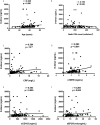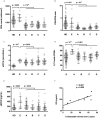Residual Viremia Is Linked to a Specific Immune Activation Profile in HIV-1-Infected Adults Under Efficient Antiretroviral Therapy
- PMID: 33859653
- PMCID: PMC8042152
- DOI: 10.3389/fimmu.2021.663843
Residual Viremia Is Linked to a Specific Immune Activation Profile in HIV-1-Infected Adults Under Efficient Antiretroviral Therapy
Abstract
Chronic immune activation persists in persons living with HIV-1 even though they are aviremic under antiretroviral therapy, and fuels comorbidities. In previous studies, we have revealed that virologic responders present distinct profiles of immune activation, and that one of these profiles is related to microbial translocation. In the present work, we tested in 140 HIV-1-infected adults under efficient treatment for a mean duration of eight years whether low-level viremia might be another cause of immune activation. We observed that the frequency of viremia between 1 and 20 HIV-1 RNA copies/mL (39.5 ± 24.7% versus 21.1 ± 22.5%, p = 0.033) and transient viremia above 20 HIV-1 RNA copies/mL (15.1 ± 16.9% versus 3.3 ± 7.2%, p = 0.005) over the 2 last years was higher in patients with one profile of immune activation, Profile E, than in the other patients. Profile E, which is different from the profile related to microbial translocation with frequent CD38+ CD8+ T cells, is characterized by a high level of CD4+ T cell (cell surface expression of CD38), monocyte (plasma concentration of soluble CD14), and endothelium (plasma concentration of soluble Endothelial Protein C Receptor) activation, whereas the other profiles presented low CD4:CD8 ratio, elevated proportions of central memory CD8+ T cells or HLA-DR+ CD4+ T cells, respectively. Our data reinforce the hypothesis that various etiological factors shape the form of the immune activation in virologic responders, resulting in specific profiles. Given the type of immune activation of Profile E, a potential causal link between low-level viremia and atherosclerosis should be investigated.
Keywords: blip; coagulation; endothelium activation; inflammation; low-level viremia; virologic responder.
Copyright © 2021 Younas, Psomas, Reynes, Cezar, Kundura, Portalès, Merle, Atoui, Fernandez, Le Moing, Barbuat, Sotto, Sabatier, Winter, Fabbro, Vincent, Reynes and Corbeau.
Conflict of interest statement
The authors declare that the research was conducted in the absence of any commercial or financial relationships that could be construed as a potential conflict of interest.
Figures




References
-
- Longenecker CT, Funderburg NT, Jiang Y, Debanne S, Storer N, Labbato DE, et al. . Markers of inflammation and CD8 T-cell activation, but not monocyte activation, are associated with subclinical carotid artery disease in HIV-infected individuals. HIV Med (2013) 14:385–90. 10.1111/hiv.12013 - DOI - PMC - PubMed
-
- Popovic M, Tenner-Racz K, Pelser C, Stellbrink H-J, van Lunzen J, Lewis G, et al. . Persistence of HIV-1 structural proteins and glycoproteins in lymph nodes of patients under highly active antiretroviral therapy. Proc Natl Acad Sci U S A (2004) 102:14807–12. 10.1073/pnas.0506857102 - DOI - PMC - PubMed
Publication types
MeSH terms
Substances
LinkOut - more resources
Full Text Sources
Other Literature Sources
Medical
Research Materials

